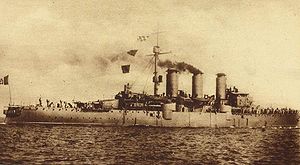 Rear quarter view of Amalfi underway at slow speed
| |
| History | |
|---|---|
| Name | Amalfi |
| Namesake | Amalfi |
| Builder | Odero, Sestri Ponente |
| Laid down | 24 July 1905 |
| Launched | 5 May 1908 |
| Completed | 1 September 1909 |
| Fate | Sunk by U-26, 7 July 1915 |
| General characteristics | |
| Class and type | Pisa-class armored cruiser |
| Displacement | 9,832 t (9,677 long tons) |
| Length | |
| Beam | 68 ft 11 in (21.01 m) |
| Draft | 22 ft 8 in (6.91 m) |
| Installed power |
|
| Propulsion |
|
| Speed | 23 knots (43 km/h; 26 mph) |
| Endurance |
|
| Armament |
|
| Armor |
|
Amalfi was a Pisa-class armored cruiser of the Italian Royal Navy (Italian: Regia Marina) built in the first decade of the 20th century. During the Italo-Turkish War of 1911–1912, Amalfi operated with the Italian fleet off Tripoli in September 1911 and participated in the amphibious landings at Derna in October. In April 1912, Amalfi and sister ship Pisa led the way in attacks on Turkish forts in the Dardanelles. After the rest of the fleet retired later in the month, the pair of armored cruisers remained in the area to attack Turkish communications facilities. After the Treaty of Lausanne signed in October 1912 ended the war, Amalfi escorted the Italian king and queen on the royal yacht to Germany and Sweden during a 1913 visit.
At the outbreak of World War I in August 1914, Italy declined to join her Triple Alliance partners, Germany and Austria-Hungary. The country was eventually persuaded to side with the Entente Powers and declared war on neighboring Austria-Hungary in May 1915. After the Austro-Hungarian Navy raided the Italian coast with relative impunity in May and June, Amalfi, Pisa, and two other armored cruisers were sent to Venice to thwart future sorties by the Austrians. Shortly after their arrival, the ships were sent—in a show of force—to patrol near the main Austrian naval base at Pola on the night of 6/7 July 1915. During Amalfi's return from that mission, she was torpedoed by Austro-Hungarian submarine U-26 (in fact SM UB-14 flying the Austro-Hungarian flag, since Germany and Italy were not yet at war) and sunk with the loss of 67 men. Amalfi's loss caused the Italians to keep the other armored cruisers at Venice in port for most of the next year before they were eventually relocated.